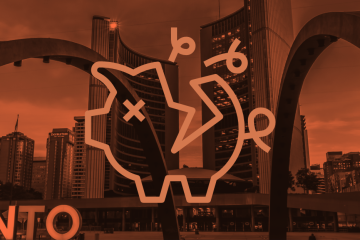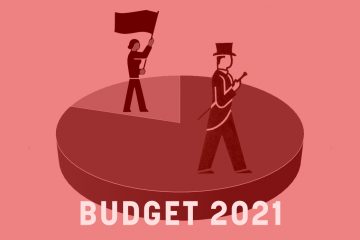As in other parts of Canada, the working class in Ontario is experiencing a deep wage and employment crisis, which threatens the living standards of millions of people in the province. But it also sees the ruling class filling its bank accounts. The provincial government’s Universal Basic Income plan – dressed up as a progressive social reform – is actually a vehicle to legislatively entrench this situation.
For the past two decades, the official poverty rate in Ontario has remained in the 10-13% range. This means that, at a minimum, over 1 million people live below the poverty line each year in the province.
Furthermore, welfare rates continue to drop further beneath the poverty line. Currently, this “poverty gap” for 160,000 single adults on social assistance is 60% – they receive only $8500 per year, $12,300 below the poverty line in Ontario. Tens of thousands cannot afford to properly feed themselves or retain their housing, leading to more hunger and homelessness.
The Ontario Association of Food Banks reported that 360,000 people used a food bank each day in 2015, with a 35% increase in the number of seniors and a total of 10,000 more food bank visits over the previous year. Conditions in northern and rural areas are worse, as people are spread over large areas, many in isolated communities.
Data from Statistics Canada shows that, while official unemployment in Ontario dropped to 6.4% in July 2016, the employment rate – the percentage of the working class who are actually working – fell to only 60.4% and continues to drop. This means that one third of the working class has simply given up on finding work, and their figures do not count toward official unemployment. Put another way, while the government counts 480,000 Ontarians as officially unemployed, the real number of working age people in Ontario who are not working is actually 4.5 million.
Among youth, employment figures are even worse. According to StatsCan, the official unemployment among young workers was 13% in June 2016, over 360,000 people. The employment rate, however, was only 55% which means nearly 2 million Ontario youth are actually without work. Of those who are working, only half have full-time jobs.
Northern Ontario is in a particularly deep crisis, with a 27% drop in employment in major industries in the region – mining, forestry, fishing, quarrying, oil and gas.
On the wage side, a 2015 study by the Broadbent Institute showed that real wages had tumbled in Ontario between 2006 and 2012, with some communities averaging devastating losses – for example, the real wage in Windsor plummeted by nearly 14%. Research by the Workers Action Centre shows that low-wage and precarious – part-time, contract, or own-account self-employed – makes up 41% of work in Ontario, and is growing. Workers in precarious employment now comprise the largest segment of the province’s working class.
The minimum wage in Ontario languishes at $11.25 per hour and is legislated to not increase beyond inflation, ensuring a permanent underpaid base that will continue to move further below the livable income level.
Among low-wage workers, women make up a disproportionate number, nearly 60% in 2012. This is partly the result of sexist hiring and promotion practices, which deny women equal job opportunities and confine women workers to low-paid, part-time jobs. A contributing factor to this confinement is the lack of affordable child care and inadequate family leave policies, combined with a disproportionate share of household work. The gender wage gap saw women in Ontario paid an average of 29.4% less than men in annual earnings in 2016. The pay gap is widest for women who face systemic discrimination because they are racialized, recent immigrants, or Aboriginal.
Against this comprehensive backdrop – one of structural unemployment, institutionalized poverty, and systemic racist and sexist oppression – the Kathleen Wynne government is promoting Basic Income as the means to alleviate poverty. The government describes the scheme as a top-up to existing programs to lift people out of poverty, but its intentions are all about cost savings and reduction of programs. When it was introduced in the February 2016 budget, the government clearly stated its goal was to “test whether a basic income would provide a more efficient way of delivering income support, strengthen the attachment to the labour force, and achieve savings in other areas, such as health care and housing supports.”
The Liberals have appointed prominent Conservative strategist Hugh Segal to develop a Basic Income pilot project. This plan will be framed in the interests of capital, to eliminate and replace other social assistance programs and lock thousands of people even more tightly into a life of severe poverty.
A Tory-planned basic income project for a pro-corporate Liberal government is being met with suspicion. As the Ontario Coalition Against Poverty noted, “the right favours a form of Basic Income because it represents a floor and the one they want to put in place is in the basement.”
According to Ontario Communist Party leader Dave McKee, “Basic Income does nothing to address issues of unemployment, precarious employment, housing, rent controls, low wages, soaring tuition rates, lack of pensions and benefits, or any of the ongoing and interconnected problems that produce and maintain poverty. We need to shift away from the whole notion of “minimums” and demand our basic rights – through full employment and livable wages, housing provided as a public utility for all who need it, free tuition, rent rollbacks. Never mind talking about “basic income” – we need guaranteed livable incomes for everyone.”
Reprinted from People’s Voice newspaper, November 3, 2016



